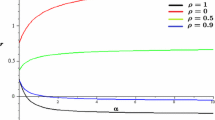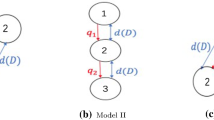Abstract
We consider a two-patch model for a single species with dispersal and time delay. For some explicit range of dispersal rates, we show that there exists a critical value τ c for the time delay τ such that the unique positive equilibrium of the system is locally asymptotically stable for τ∈[0,τ c ) and unstable for τ>τ c .


Similar content being viewed by others
References
Busenberg, S., & Huang, W. (1996). Stability and Hopf bifurcation for a population delay model with diffusion effects. J. Differ. Equ., 124, 80–107.
Cantrell, R. S., & Cosner, C. (2003). Spatial ecology via reaction-diffusion equations. Series in mathematical and computational biology. Chichester: Wiley.
Chen, S., & Shi, J. (2012). Stability and Hopf bifurcation in a diffusive logistic population model with nonlocal delay effect. J. Differ. Equ., 253, 3440–3470.
Chen, S., Shi, J., & Wei, J. (2013). Time delay-induced instabilities and Hopf bifurcations in general reaction-diffusion systems. J. Nonlinear Sci., 23, 1–38.
Cooke, K., van den Driessche, P., & Zou, X. (1999). Interaction of maturation delay and nonlinear birth in population and epidemic models. J. Math. Biol., 39, 332–352.
Davidson, F. S., & Gourley, S. A. (2001). The effects of temporal delays in a model for a food-limited, diffusing population. J. Math. Anal. Appl., 261, 633–648.
Feng, W., & Lu, X. (1999). On diffusive population models with toxicants and time delays. J. Math. Anal. Appl., 233, 373–386.
Gourley, S. A., & Ruan, S. (2000). Dynamics of the diffusive Nicholson’s blowflies equation with distributed delay. Proc. R. Soc. Edinb., Sect. A, 130, 1275–1291.
Gourley, S. A., & So, J. W.-H. (2002). Dynamics of a food-limited population model incorporating nonlocal delays on a finite domain. J. Math. Biol., 44, 49–78.
Hassard, B. D., Kazarinoff, N. D., & Wan, Y. H. (1981). Theory and applications of Hopf bifurcation. Cambridge: Cambridge University Press.
He, X., Wu, J., & Zou, X. (1998). Dynamics of single species populations over a patchy environment. In L. Chen et al. (Eds.), Advanced topics in biomathematics, Singapore: World Scientific.
Kuang, Y. (1993). Delay differential equations with applications in population dynamics. San Diego: Academic Press
Liao, K.-L., Shih, C.-W., & Tseng, J.-P. (2012). Synchronized oscillations in mathematical model of segmentation in zebrafish. Nonlinearity, 25, 869–904.
Madras, N., Wu, J., & Zou, X. (1996). Local-nonlocal interaction and spatio-temporal patterns in single-species population over a patch environment. Can. Appl. Math. Q., 4, 109–134.
Memory, M. C. (1989). Bifurcation and asymptotic behaviour of solutions of a delay-differential equation with diffusion. SIAM J. Math. Anal., 20, 533–546.
Morita, Y. (1984). Destabilization of periodic solutions arising in delay-diffusion systems in several space dimensions. Jpn. J. Appl. Math., 1, 39–65.
Shi, X., Cui, J., & Zhou, X. (2011). Stability and Hopf bifurcation analysis on an eco-epidemic model with a stage structure. Nonlinear Anal., 74, 1088–1106.
Smith, H. L. (1996). Monotone dynamical system: an introduction to the theory of competitive and cooperative systems. Rhode Island: Am. Math. Soc.
So, J. W.-H., Wu, J., & Yang, Y. (2000). Numerical steady state and Hopf bifurcation analysis on the diffusive Nicholson’s blowflies equation. Appl. Math. Comput., 111, 33–51.
So, J. W.-H., & Yang, Y. (1998). Dirichlet problem for the diffusive Nicholson’s blowflies equation. J. Differ. Equ., 150, 317–348.
Song, Y., Zhang, T., & Tadé, M. O. (2009). Stability switches, Hopf bifurcations, and spatio-temporal patterns in a delayed neural model with bidirectional coupling. J. Nonlinear Sci., 19, 597–632.
Su, Y., Wei, J., & Shi, J. (2009). Hopf bifurcations in a reaction-diffusion population model with delay effect. J. Differ. Equ., 247, 1156–1184.
Su, Y., Wei, J., & Shi, J. (2010). Bifurcation analysis in a delayed diffusive Nicholson’s blowflies equation. Nonlinear Anal., Real World Appl., 11, 1692–1703.
Sun, C., Lin, Y., & Han, M. (2006). Stability and Hopf bifurcation for an epidemic disease model with delay. Chaos Solitons Fractals, 30, 204–216.
Wan, A., & Zou, X. (2009). Hopf bifurcation analysis for a model of genetic regulatory system with delay. J. Math. Anal. Appl., 356, 464–476.
Wang, L., & Zou, X. (2004). Hopf bifurcation in bidirectional associative memory neural networks with delays: analysis and computation. J. Comput. Appl. Math., 167, 73–90.
Wang, L., & Zou, X. (2005). Stability and bifurcation of bidirectional associative memory neural networks with delayed self-feedback. Int. J. Bifurc. Chaos, 15, 2145–2159.
Wei, J., & Zou, X. (2006). Bifurcation analysis of a population model and the resulting SIS epidemic model with delay. J. Comput. Appl. Math., 197, 169–187.
Xu, C., & Li, P. (2012). Dynamical analysis in a delayed predator–prey model with two delays. Discrete Dyn. Nat. Soc.. doi:10.1155/2012/652947.
Xu, C., Tang, X., & Liao, M. (2010). Stability and bifurcation analysis of a delayed predator–prey model of prey dispersal in two-patch environments. Appl. Math. Comput., 216, 2920–2936.
Xu, X., & Wu, Y. (2012). The effect of time delay on dynamical behavior in an ecoepidemiological model. J. Appl. Math. doi:10.1155/2012/286961.
Yi, T., & Zou, X. (2010). Map dynamics versus dynamics of associated delay reaction-diffusion equations with a Neumann condition. Proc. R. Soc. A, 466, 2955–2973.
Yoshida, K. (1982). The Hopf bifurcation and its stability for semilinear diffusion equations with time delay arising in ecology. Hiroshima Math. J., 12, 321–348.
Yu, W., & Cao, J. (2006). Stability and Hopf bifurcation analysis on a four-neuron BAM neural network with time delays. Phys. Lett. A, 351, 64–78.
Acknowledgements
The authors are grateful to two anonymous reviewers for their helpful comments which substantially improved the manuscript. They thank Profs. Stephan van Gils, Chih-Wen Shih and Chang-Yuan Cheng and Kuang-Hui Lin for helpful discussions. This research was partially supported by the National Science Council of Taiwan, R.O.C., under No. NSC 101-2917-I-564-062 (K.-L. Liao), the NSF under Agreement No. 0635561 (K.-L. Liao), and the NSF Grant DMS-1021179 (Y. Lou), and has been supported in part by the Mathematical Biosciences Institute and the National Science Foundation under Grant DMS-0931642.
Author information
Authors and Affiliations
Corresponding author
Appendices
Appendix A
In this part, we display the main steps of using the center manifold theorem and the normal form method to analyze the stability and the bifurcating direction of the bifurcating periodic orbits for Neumann boundary problem (5). See the details in Hassard et al. (1981), Liao et al. (2012), Yu and Cao (2006). Herein, we use the supremum norm ∥ϕ∥=sup−τ≤θ≤0|ϕ(θ)|. Hence, the phase space \(\mathcal{C}:=\mathcal {C}([-\tau,0],\mathbb{R}^{2 })\) is a Banach space of continuous functions.
Denote the solution of (5) as \({\mathbb{U}}(t)= (u_{1}(t), u_{2}(t))^{T}\), and set \({\mathbb{U}}_{t}(\theta)={\mathbb{U}}(t+\theta)\), θ∈[−τ,0], ν:=τ−τ c , where T denotes the transpose. Then, we can rewrite (11) in the form
with the linear operator \(L_{\nu}:\mathcal{C}\rightarrow \mathbb{R}^{2}\) and the nonlinear operator \(G_{\nu}:\mathcal {C}\rightarrow\mathbb{R}^{2}\). More precisely, L ν is defined by
with
In addition, by using the steady-state system (14), M 0 can be rewritten as
We can choose
where δ(⋅) is the Dirac function and η(⋅,μ) is obtained from the Riesz representation theorem, that its entries are functions of bounded variation on [−τ,0] such that
On the other hand, the operator \(G_{\nu}:\mathcal{C}\rightarrow\mathbb{R}^{2}\) is defined by
Next, we define two operators on \(\mathcal{C}^{1} := \mathcal{C}^{1}([-\tau ,0],\mathbb{R}^{2})\):
and transform (100) into
Note that the adjoint operator \(A^{\ast}_{\nu}\) of A ν is defined as
where \(\psi\in\mathcal{C}^{1}([0,\tau],\mathbb{R}^{2})\). For convenience, we allow functions to have range in \(\mathbb{C}^{2}\), instead of merely \(\mathbb{R}^{2}\), in the following computation.
We define the following bilinear form:
for \(\phi\in\mathcal{C}([-\tau,0],\mathbb{C}^{2})\), \(\psi\in\mathcal {C}([0,\tau],\mathbb{C}^{2})\), where η(θ):=η(θ,0), to determine the coordinates of the center manifold near the origin of (100). Note that the overline stands for complex conjugate.
Next, we aim at finding the eigenvectors q(θ) and q ∗(θ ∗) of A:=A 0 and \(A^{\ast}:=A^{\ast}_{0}\) with purely imaginary eigenvalues iw c and −iw c , respectively; namely,
which satisfy the normalized conditions 〈q ∗,q〉=1 and \(\langle q^{\ast},\bar{q} \rangle=0\). Hence, we set
for θ∈[−τ,0), θ ∗∈(0,τ], and \(q(0)=(q_{1}, q_{2})^{T}, q^{\ast}(0)=\frac{1}{\rho}(q_{1}^{\ast}, q^{\ast}_{2})^{T}\), and substitute (109) into (108) at θ=0 to yield
In the sequel, 〈q ∗,q〉=1 and \(\langle q^{\ast},\bar {q}\rangle=0\), if we set
where \(J_{1}:=-\mu(a q_{1} \overline{q_{1}^{\ast}}+b q_{2} \overline{q_{2}^{\ast}})\).
Next, by using q and q ∗, we can then construct a coordinate for the center manifold Ω 0 at ν=0. Denote \({\mathbb{U}}_{t}={\mathbb{U}}_{t}(\theta)=(u_{1,t}(\theta), u_{2,t}(\theta))^{T}\) as a solution of (107), and define
According to the center manifold reduction, we have \(W(t,\theta)= W(z(t),\bar{z}(t),\theta)\) on Ω 0. By the tangency to the center eigenspace at the equilibrium, we further have
where z and \(\bar{z}\) are the local coordinates of the center manifold Ω 0 in directions q ∗ and \(\overline{{q}^{\ast}}\), respectively.
Accordingly, the solution \({\mathbb{U}}_{t}\in\varOmega_{0}\) of (107), at ν=0, satisfies
with
and
where \(W_{20}^{(k)}(\theta)\) and \(W_{11}^{(k)}(\theta)\) are the kth components of W 20(θ) and W 11(θ), respectively, for −τ≤θ<0. Note that W 20(θ) and W 11(θ) are defined by
where
Accordingly, we already derive all formulas to find the values of g 20,g 11,g 02, and g 21. We can then determine the magnitudes of C 1(0),ν 2,ζ 2, and T 2.
Appendix B
Comparing with Appendix A, herein we consider the center manifold theorem and the normal form method for Dirichlet boundary problem (6) to analyze the stability and the bifurcating direction of the bifurcating orbits. In space \(\mathcal{C}:=\mathcal{C}([-\tau,0],\mathbb{R}^{2 })\) with the supremum norm ∥ϕ∥=sup−τ≤θ≤0|ϕ(θ)|, we denote the solution of (6) as \(\tilde{{\mathbb{U}}}(t)= (u_{1}(t), u_{2}(t))^{T}\) and set \(\tilde{{\mathbb{U}}}_{t}(\theta)=\tilde{{\mathbb{U}}}(t+~\theta), \theta\in[-\tau, 0]\), and \(\nu:=\tau-\tilde{\tau}_{c}\). Then, system (40) can be rewritten as
with the linear operator \(\tilde{L}_{\nu}:\mathcal{C}\rightarrow \mathbb{R}^{2}\) and the nonlinear operator \(\tilde{G}_{\nu}:\mathcal {C}\rightarrow\mathbb{R}^{2}\). More precisely, \(\tilde{L}_{\nu}\) is defined by
with
By using the steady-state system (43), we rewrite \(\tilde{M}_{0}\) as
We then choose
where \(\tilde{\delta}(\cdot)\) is the Dirac function and \(\tilde{\eta }(\cdot,\mu)\) is obtained from the Riesz representation theorem, that its entries are functions of bounded variation on [−τ,0] such that
On the other hand, the operator \(\tilde{G}_{\nu}:\mathcal{C}\rightarrow \mathbb{R}^{2}\) is defined by
By using the steady-state systems (14) and (43), the structures of \(\tilde{M}_{0}\) in (122) and M 0 in (102) are totally the same. In addition, the structures of \(\tilde{M}_{1}\) and M 1 are also the same with each other and the formulas of the linear and nonlinear operators \(\tilde {L}_{\nu}\) and \(\tilde{G}_{\mu}\) of system (120) are very similar to L μ and G μ for system (100) in Appendix A. Accordingly, the analysis and formulas in center manifold theorem and the normal form method of these two systems (5) and (6) are almost the same. More precisely, all formulas for system (6) are obtain from replacing the values a,b by \(\tilde{a},\tilde{b}\) in Appendix A. Therefore, we omit the details of center manifold theorem and the normal form method for system (6).
Rights and permissions
About this article
Cite this article
Liao, KL., Lou, Y. The Effect of Time Delay in a Two-Patch Model with Random Dispersal. Bull Math Biol 76, 335–376 (2014). https://doi.org/10.1007/s11538-013-9921-7
Received:
Accepted:
Published:
Issue Date:
DOI: https://doi.org/10.1007/s11538-013-9921-7




